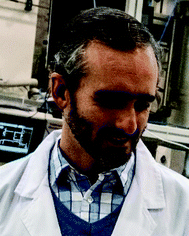Materials Horizons Emerging Investigator Series: Juan José Vilatela, IMDEA Materials Institute, Spain
Juan José Vilatela is the leader of the Multifunctional Nanocomposites Group at IMDEA Materials, in Madrid, Spain. During his PhD and postdoc at the University of Cambridge he was involved in early developments of a process to make continuous macroscopic fibres made up of CNTs, and took part in the transfer of this technology to industry. His group's work is focused on the development of macroscopic materials made up of nanobuilding blocks in a way that preserves the unique properties at the nanoscale through the assembly process and produces a new generation of high-performance engineering materials. The group pursues molecular control in synthesis of nanostructured fibres, methods to hybridize them with polymers and inorganic materials, the use of advanced X-ray and spectroscopic techniques to establish structure–property relations in these complex hierarchical systems and the study of reinforcement and energy storage/transfer in nanostructured systems. He has coordinated several European projects, industrial contracts (e.g. Toyota, Airbus, AFOSR) and is currently the recipient of an ERC Starting Grant to develop structural energy harvesting composite materials. He was awarded the 2016 young investigator award by the European Society for Composite Materials and the 2018 “Miguel Catalán” under 40 investigator award by the Madrid Regional Government. Since 2014 he has been an associate lecturer at the Carlos III de Madrid University and at the Technical University of Madrid in its Airbus-UPM master's programme. He is a member of the Early Career Researcher Board of IOP Multifunctional Materials.
Read Juan José Vilatela's Emerging Investigator Series article ‘‘ Tough sheets of nanowires produced floating in the gas phase ” and read more about him in the interview below:
MH: Your recent Materials Horizons Communication reports a new method for the large-scale, continuous synthesis of inorganic nanowires and their direct assembly into macroscopic structures resembling tough fabrics or sheets. How has your research evolved from your first article to this most recent article and where do you see your research going in future?
JJV: My first article is in fact closely related to this publication. It described a process to assemble carbon nanotubes into continuous yarns with exceptionally high strength, published in Science in 2007. Looking back, I think a key aspect of that work was to look at the problem from a new different perspective; I started viewing carbon nanotubes as unusual polymers and applying old polymer fibre chemistry methods to align polymer chains in fibres. Once we were able to align and pack the CNTs into continuous fibres, excellent axial properties followed.
Since 2007 my research has kept a focus on studying macroscopic ensembles of nanobuilding blocks, but mainly using those carbon nanotube yarns as a starting material. A few years ago, I looked at the situation from a different angle and wondered if it would be possible to produce yarns or sheets of inorganic nanowires by synthesising them floating in the gas phase and directly assembling them into macroscopic solids. This paper presents the confirmation of this idea.
I see it as a new stage for my research, now directed towards exploring the fabrication of what we believe to be a long list of nanomaterials suitable for such assembly routes, and demonstrating their application for energy storage and conversion.
MH: What aspect of your work are you most excited about at the moment?
JJV: I am excited about the prospect of synthesising macroscopic materials never produced before and whose properties are unknown; it is an idyllic situation for a materials scientist. The whole challenge, ranging from controlling the synthesis process to establishing clear relations between the structure of these complex 1D networks and their bulk properties, is very appealing, as it touches on multiple areas of research, including aerosol science, metallurgy, low-dimensional physics, catalysis, etc. We have a particular interest in analysing the unusual combination of high crystallinity, porosity and toughness through synchrotron X-ray methods.
MH: In your opinion, what are the most important questions to be asked/answered in this field of research?
JJV: A very important practical question is whether floating catalyst chemical vapour deposition is scalable to industrial levels. Ensuring that large volumes of these materials can be produced is key to foster their potential. Answering it will require not only chemical engineering analysis of scale up, but also going deep into the synthesis reaction mechanism to understand in more detail why it produces exceptionally fast growth rates compared to traditional 1D nanomaterials synthesis methods.
MH: What do you find most challenging about your research?
JJV: One of the biggest challenges is in combining breadth and depth. It makes it hard to keep track of the state of the art in the field and to supervise students properly. Exploring many topics of research can give a broad perspective on the problems we try to solve, but can bring with it a sense of lacking focus.
MH: In which upcoming conferences or events may our readers meet you?
JJV: At Euromat 2021, in Graz, Austria. I am co-organising a symposium on Nanostructured Network Materials. The symposium aims at bringing together scientists across different fields to identify a common ground to improve current understanding on the structure–property relations in nanostructured network materials, to identify methods to control their assembly at the point of fabrication to control bulk behaviour and to consolidate future trends.
MH: How do you spend your spare time?
JJV: I enjoy spending time with my wife and two small children, and cycling in the mountains.
MH: Can you share one piece of career-related advice or wisdom with other early career scientists?
JJV: When work seems overwhelming, trust your intuition and look for that aspect of research that makes you passionate about your job.
| This journal is © The Royal Society of Chemistry 2020 |

